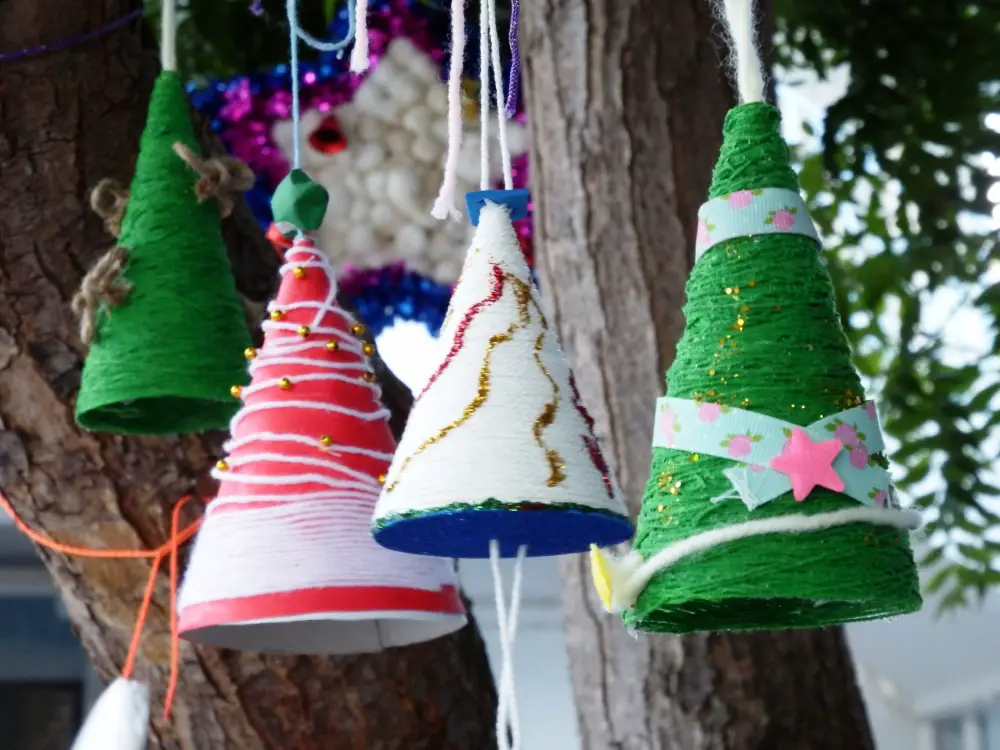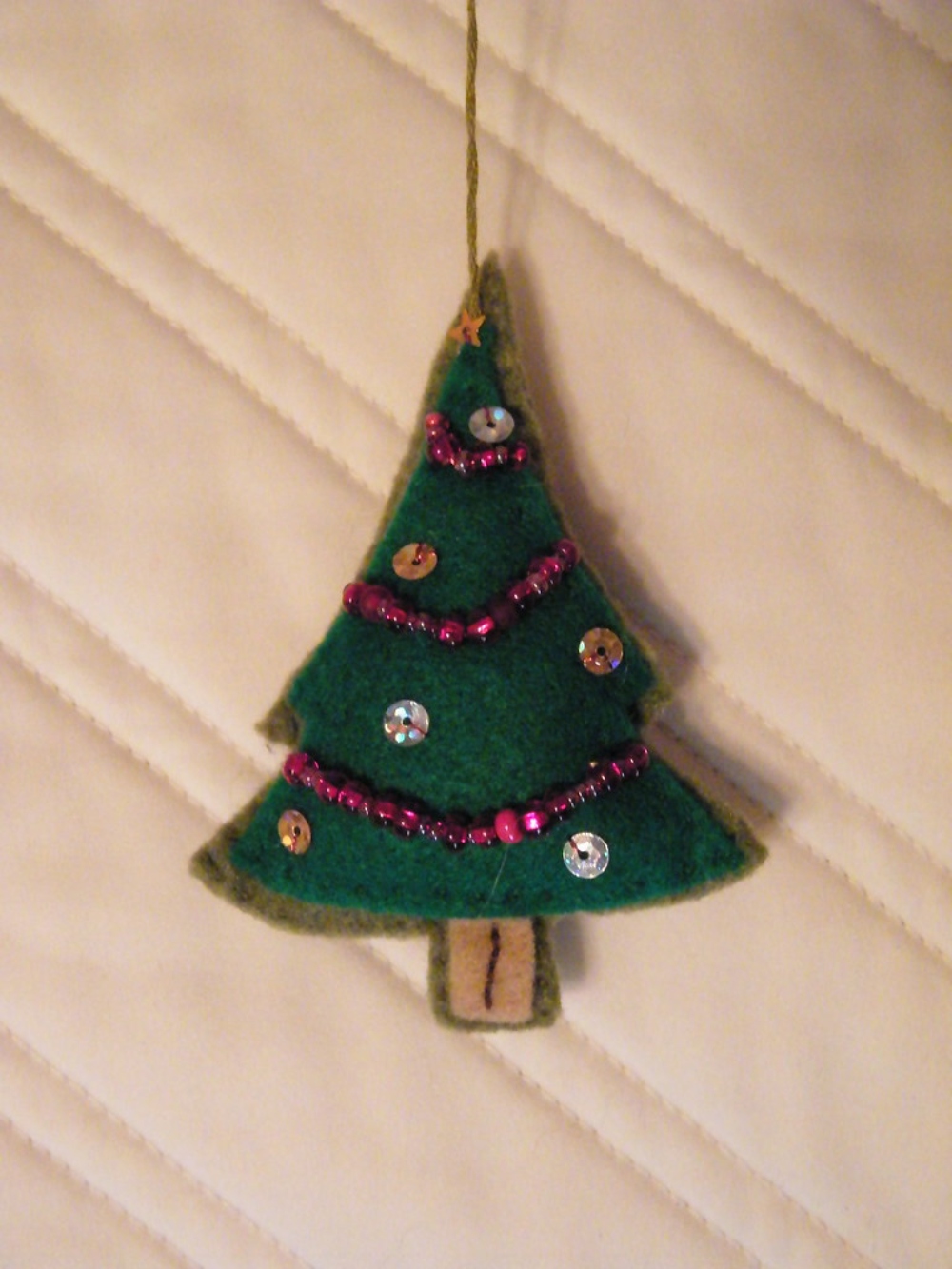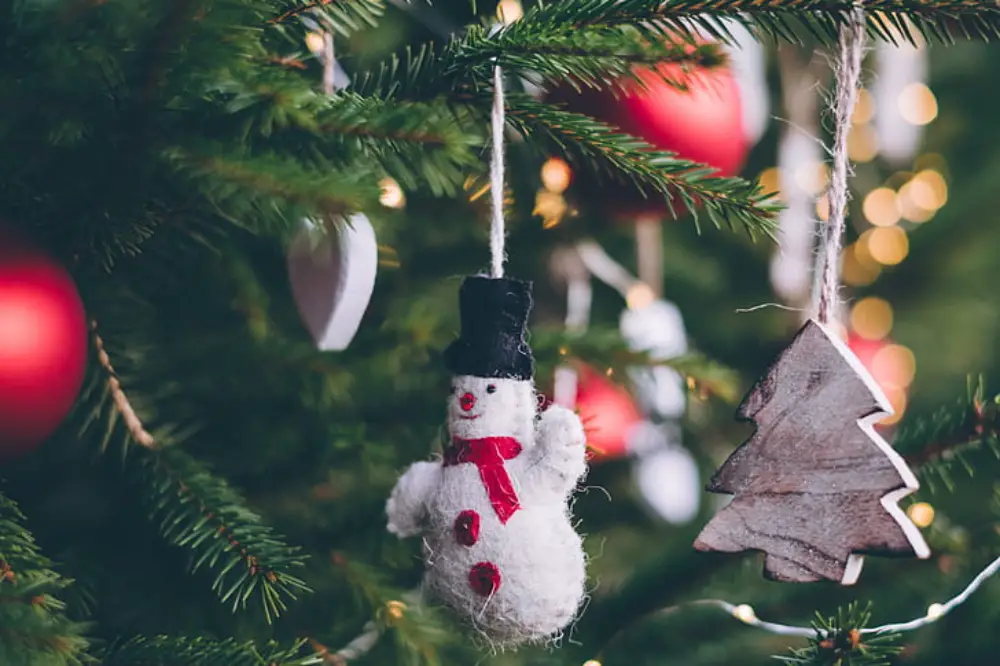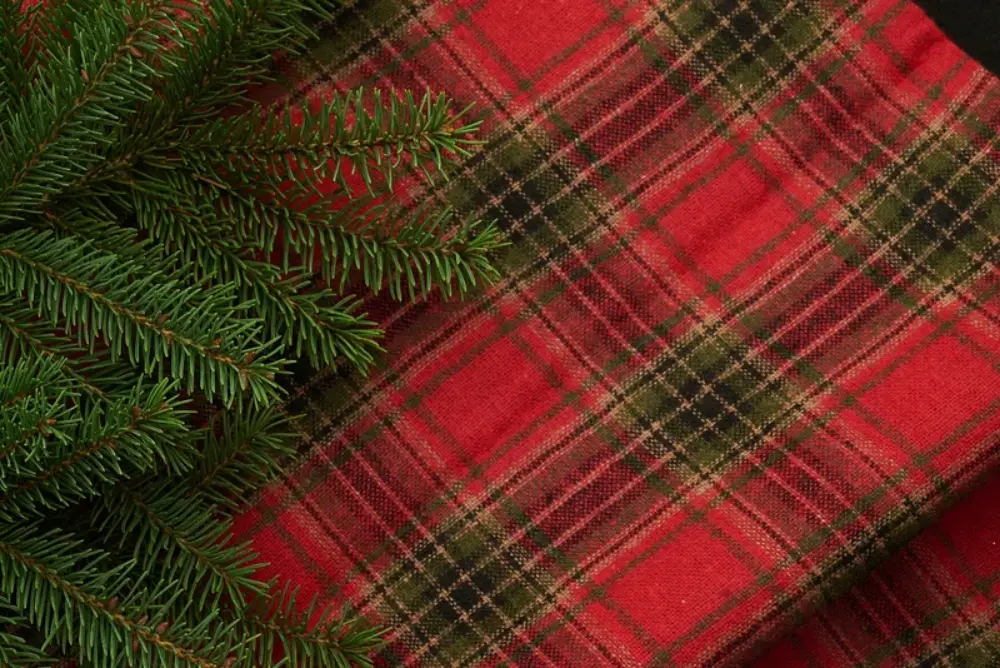Fabric Christmas trees are a delightful addition to holiday decorations, offering a unique and personalized touch. This DIY decoration brings a homemade aesthetic to your festive celebrations.
We help you construct your DIY fabric Christmas trees with our comprehensive guide, providing creative ideas and practical how-to steps.
Contents [show]
Step-by-Step Creation Guide
Creating fabric Christmas trees can be a fun and rewarding DIY project. This step-by-step guide will walk you through the process, ensuring your fabric Christmas trees turn out beautifully.
1. Prepare Your Fabric
- Choosing the Right Size: Decide on the size of your fabric Christmas trees. This will determine how much fabric you need. A standard size might be around 10-12 inches tall, but this can vary based on your preference.
- Cutting the Fabric: Lay your fabric flat on a cutting surface. Use a template or draw a triangular shape directly onto the fabric with a fabric marker or chalk. For a more detailed tree, you might add curves or indentations to simulate branches. Cut carefully along your lines with fabric scissors.
- Removing Wrinkles: Ironing your fabric pieces ensures they’re free from wrinkles, which can affect the final appearance of your fabric Christmas trees. Use an iron setting appropriate for the type of fabric you’re using. Ironing also helps to pre-shrink the fabric if it’s prone to shrinking. This is particularly important if you plan to wash your fabric Christmas trees.
2. Sewing the Pieces Together
- Aligning the Edges: When pinning two pieces of fabric together, ensure the edges align perfectly. This precision will make your sewing easier and the final product more symmetrical.
- Right Sides Together: Always remember to have the right sides of the fabric facing each other. This means the fabric’s patterned or more vibrant side should be on the inside, as it will be turned out later.
- Sewing Machine vs. Hand Sewing: If using a sewing machine, set it to a straight stitch and sew around the edges, maintaining a uniform seam allowance (usually about ¼ inch). If hand sewing, use a backstitch for strength. The backstitch will ensure that your fabric Christmas trees are durable and can withstand handling.
- Leaving an Opening: Remember to leave an opening at the bottom of your tree. This should be wide enough to turn the fabric right side out and to stuff the tree later. A good rule of thumb is to leave an opening about 2-3 inches wide.

3. Adding the Base
- Creating a Stable Base: A stable base is essential for your fabric Christmas trees to stand upright. You can use a heavier fabric like felt or canvas for this purpose. Cut the base fabric into a circle slightly smaller than the width of your tree’s bottom.
- Attaching the Base: Align the base circle with the bottom of your tree. If you’re sewing, pin the base and carefully sew around the edge, ensuring it’s securely attached. For a no-sew option, use fabric glue to attach the base, applying pressure until it sets.
- Considerations for a Flat Base: If you prefer a flat-base design, skip the stuffing step and simply sew or glue the base to the bottom, allowing the fabric Christmas tree to lay flat as a decorative mat or wall hanging.
4. Stuffing the Tree
- Choosing the Right Stuffing Material: The choice of stuffing can affect the shape and feel of your fabric Christmas trees. Polyester fiberfill is a popular choice due to its lightness and malleability. Consider using cotton batting or even repurposed fabric scraps for a more eco-friendly option.
- Filling the Tree: Start stuffing your fabric Christmas tree through the opening at the bottom. Use a tool like a chopstick or the back of a pencil to push the stuffing into the corners and edges. This helps to shape the tree and ensures an even fill, avoiding lumps and bumps.
- Determining the Amount of Stuffing: The amount of stuffing will determine how firm or soft your fabric Christmas tree will be. For a firmer tree, pack the stuffing tightly. For a softer look, use less stuffing. Be careful not to overstuff, as this can strain the seams.
- Closing the Tree: Close the opening once satisfied with the shape and firmness. If you left a seam allowance, fold it inside, and hand sew the opening shut with small, discreet stitches. For a no-sew option, use fabric glue, carefully pressing the edges together for a neat finish.
5. Decorating Your Tree
- Choosing Decorations: The decoration phase is where you can personalize your fabric Christmas trees. Select from embellishments like beads, sequins, ribbons, miniature ornaments, or small lights. Consider the overall theme and color scheme of your tree when choosing decorations.
- Attaching Embellishments: Use a needle and thread that matches or complements your fabric for sewing on decorations. This is ideal for attaching beads or buttons. For ribbons, fabric glue or discreet stitches at the ends can secure them. If using hot glue, apply it carefully to avoid seepage that could stiffen the fabric.
- Adding a Tree Topper: A tree topper adds a finishing touch to your fabric Christmas trees. This could be a small star, angel, bow, or any other festive element that complements the tree’s design. Attach it securely at the top, either by sewing or with glue.
- Layering for Depth: Layer your decorations to add depth and interest. Start with larger elements at the bottom and work to smaller, finer details near the top.

6. Final Touches
- Inspecting the Craftsmanship: Once your fabric Christmas tree is decorated, step back and inspect it. Look for loose threads or uneven areas that might need extra attention.
- Adjusting for Balance: Ensure that your tree stands straight and any decorations are evenly distributed. This might mean adjusting the stuffing or base or repositioning some ornaments.
- Cleaning Up Edges: If there are any frayed edges or excess glue, clean these up for a more polished look. For frayed edges, a small pair of scissors can trim away any loose threads.
- Display Considerations: Consider where and how to display your fabric Christmas tree. If it’s part of a larger display, consider how it interacts with other elements in height, color, and texture.
Exploring the Charm of Fabric Christmas Trees
Fabric Christmas trees bring a unique and creative flair to holiday decorations. They stand out with their handcrafted beauty and offer endless possibilities for customization. In this section, we delve into the allure of these charming holiday additions.
A Touch of Handmade Elegance
Fabric Christmas trees exude a handmade elegance that can’t be found in store-bought decorations. Each tree tells a story, reflecting the crafter’s style and creativity. The tactile appeal of fabric adds warmth and coziness to your holiday decor, making your space more inviting.
Endless Design Possibilities
With fabric Christmas trees, the design possibilities are limitless. The choice of fabric sets the tone from rustic burlap to elegant satin. Experimenting with patterns, textures, and colors allows for various traditional and modern styles.
Eco-Friendly and Sustainable
Fabric Christmas trees are an excellent choice for eco-conscious decorators. You contribute to a more sustainable holiday season by using upcycled or recycled fabrics. These trees can be reused year after year, reducing waste and offering a more environmentally friendly option than traditional trees.
Fabric Christmas trees offer a wonderful opportunity to add a personal and eco-friendly touch to your holiday celebrations. Their handmade charm and versatility make them a beloved choice for festive decorating.
Selecting the Perfect Material for Fabric Christmas Trees
Choosing the right fabric is crucial in creating beautiful Christmas tree fabric. This section provides guidance on picking fabrics that will bring your fabric Christmas trees to life.
Consider the Theme and Color Scheme
Selecting fabric for your fabric Christmas trees involves thoughtful consideration of your holiday decor’s overall theme and color scheme. This decision sets the tone for your festive creations.
Think about the atmosphere you want to create. Classic patterns like plaids or prints depicting holiday motifs work well for a traditional setting. If your style leans towards modern, consider geometric patterns or minimalist designs. Bright colors and fun prints like polka dots or cartoon characters can add a lively touch for a whimsical or playful theme.
While reds and greens are time-honored choices for fabric Christmas trees, expanding your palette can offer a fresh perspective. Blues and silvers can evoke a winter wonderland feel, while pastels bring a soft, serene touch.
Bold and bright hues can make your fabric Christmas trees stand out and become a focal point of your decor. Remember, your chosen colors should harmonize with other decorations in your space to create a cohesive look.

Texture and Durability
The texture and durability of the fabric are key factors in creating appealing and long-lasting fabric Christmas trees.
The right texture can dramatically enhance the appearance of your fabric Christmas trees. Velvets and felts are excellent for adding a touch of luxury and warmth, making your trees feel cozy and inviting. Cotton, with its vast range of prints and hues, offers versatility and a clean, crisp appearance. For a more rustic look, consider burlap or linen, which bring an earthy and natural feel.
If you intend to use your fabric Christmas trees for multiple seasons, choose fabrics that maintain their color and shape over time. High-quality cotton, wool blends, and synthetic fibers are generally durable and less prone to fading or fraying.
Also, consider the care required for the fabric; some may need gentle cleaning methods to preserve their appearance. Durable fabrics ensure that your fabric Christmas trees last longer and reduce the need for replacements, making your holiday decorations more sustainable.
Eco-Friendly Fabric Choices
Opting for eco-friendly fabrics for your fabric Christmas trees is an excellent way to blend creativity with environmental responsibility. This choice reflects a commitment to sustainability while adding a unique touch to your holiday decor.
Organic fabrics are a fantastic choice for fabric Christmas trees. They are produced without harmful pesticides and chemicals, making them better for the environment and often more pleasant to handle.
Organic cotton, hemp, and bamboo fabrics are popular options. These materials support sustainable farming practices and provide a natural and authentic feel to your decorations.
Upcycling is a creative and eco-friendly approach. Look around your home for old clothing, linen, or curtains that can be repurposed. Even old holiday garments with festive patterns can be transformed into charming fabric Christmas trees.
Upcycled fabrics are environmentally friendly. They also carry sentimental value, adding a layer of personal history to your crafts.
Many fabric stores sell remnants at reduced prices. Often left over from larger rolls, these pieces are perfect for smaller projects like fabric Christmas trees.
Using remnants helps reduce waste, and you can often find high-quality materials at a lower cost. This approach allows for a diverse range of fabrics, potentially leading to an eclectic and vibrant collection of fabric Christmas trees.
Essential Supplies and Tools
Creating fabric Christmas trees requires some basic supplies and tools. Having the right equipment on hand makes the process smoother and more enjoyable. This section covers the essentials to start your fabric Christmas tree project.
- Fabric: Choose your fabric based on the earlier guidelines. You’ll need enough to cover the desired size of your fabric Christmas trees.
- Sewing Machine or Needle and Thread: A sewing machine can speed up the process, but hand sewing is also perfectly suitable.
- Scissors: A sharp pair of fabric scissors makes cutting your material easier and more precise.
- Straight Pins or Fabric Clips: These help hold fabric pieces together before sewing, ensuring accuracy in your design.
- Iron and Ironing Board: Ironing your fabric before cutting can improve accuracy and give a more professional finish to your fabric Christmas trees.
- Measuring Tape or Ruler: Essential for measuring fabric and ensuring that your cuts are the correct size and shape.
- Template or Pattern: A template for your tree shape can be handmade or printed from online resources.
- Stuffing Material: For three-dimensional fabric Christmas trees, stuffing material like polyester fiberfill will give them shape.
- Embellishments: Consider beads, sequins, ribbons, or buttons for decorating your trees.
- Glue or Hot Glue Gun: Useful for attaching decorations that can’t be sewn on.
- Storage Bins or Bags: Keep your supplies organized and in one place, especially if your project spans several days.
- Labels: If you have multiple types of fabric or decorations, labeling them can help keep your workspace organized.

Advanced Design Ideas
For those looking to take their fabric Christmas trees to the next level, these advanced design ideas can add complexity and appeal to your creations.
Mixed Media Trees
Mixed media trees offer an opportunity to blend various materials and textures, creating a unique and artistic fabric Christmas tree.
Start by selecting fabrics that contrast yet complement each other. For instance, pair the smoothness of satin with the rustic feel of burlap or the delicacy of lace with the sturdiness of denim. These combinations can create visual interest and tactile appeal.
To add further dimension, incorporate non-fabric elements. Metal charms can give a vintage feel, wooden beads add a natural touch, and small mirrors or sequins can bring sparkle and light reflection. Attach these elements with sewing or fabric glue, considering the balance and distribution to enhance the tree’s overall aesthetics.
When placing mixed media elements, consider how they interact with the fabric. For example, a lace overlay on a solid fabric can create an elegant look, while metal or wooden elements can act as focal points or mimic natural tree decorations.
Quilted Fabric Trees
Quilted fabric trees allow for the incorporation of detailed fabric work, creating a cozy and intricate fabric Christmas tree.
Gather various fabric scraps in different colors and patterns for a quilted look. Cut them into squares, triangles, or other shapes, and sew them together to create a patchwork design. This method uses leftovers from other projects, adding to the tree’s story and uniqueness.
Embossed textures on your fabric Christmas trees can be achieved through quilting. Layer your main fabric over the batting and a backing layer. Sew along predetermined lines or shapes to create raised patterns. These could be simple lines, creating a geometric pattern, or more complex shapes like stars or snowflakes.
Choose colors that work well together, maintaining a cohesive look. You could stick to a traditional Christmas palette or experiment with unconventional color schemes. Remember, the quilted parts can be the main feature, so choose colors that stand out and complement the overall design of your tree.
Dimensional Designs
Creating dimensional designs in fabric Christmas trees can add depth and realism, making them more visually engaging.
To create a layered branch effect, cut strips or shapes of fabric that resemble tree branches or pine needles. Attach these pieces in layers starting from the bottom and working upwards. This layering can be done by sewing or with fabric glue.
Use varying lengths and shades of green for a more natural look. For a fuller tree, increase the number of layers and ensure they overlap sufficiently.
To create a sculptural fabric Christmas tree, incorporate flexible materials like wire or bendable mesh inside the fabric. This allows the tree to be shaped in various forms, from traditional conical shapes to more abstract designs.
Cover the wire with fabric, sewing along its length to create channels that hold it in place. Once the basic shape is formed, you can bend and adjust it to achieve your desired look.
LED Light Integration
Integrating LED lights into fabric Christmas trees can bring a magical and festive illumination to your decoration.
Decide whether you want the lights inside the tree for a diffused glow or wrapped around the exterior for a sparkling effect. If you place lights inside, choose a somewhat translucent fabric to showcase the lights better. For external placement, small LED fairy lights work well.
For internal lighting, sew a pocket or a compartment to house the battery pack, ensuring it’s accessible for switching the lights on and off or for battery replacement. For lights wrapped around the tree, you can sew small loops or use fabric glue to secure the light string in place.
Always use LED lights as they generate less heat and are safer for use with fabric. Ensure the battery pack is securely enclosed and the lights evenly distributed to prevent any strain or damage to the fabric.
Battery-operated lights are preferable for ease of use and placement flexibility. Choose lights with a timer function for convenience, and check the battery life to ensure they last through your desired display period.
Themed Trees
Themed fabric Christmas trees can reflect personal interests, match decor styles, or celebrate specific aspects of the holiday season.
Choose a theme that resonates with your holiday spirit. For example, a winter wonderland theme could feature whites and blues with snowflake embellishments. A Victorian-themed tree might include rich colors, lace, and vintage-style ornaments. For a children’s room, consider a fairy-tale or cartoon character theme.
Create a cohesive look with a focused color scheme. Monochromatic trees can be striking and modern, using different shades of the same color. Metallic themes with golds, silvers, and bronzes offer a sophisticated and elegant look. Pastel colors can create a soft, serene holiday atmosphere.
Customize your tree with decorations that align with your chosen theme. For instance, nautical-themed trees might include miniature boats and lighthouses, while rustic-themed trees could be adorned with wooden ornaments and burlap ribbons.
Interactive Elements
Adding interactive elements to fabric Christmas trees can enhance enjoyment and engagement, especially for kids.
Sew small pockets onto your tree, turning it into an advent calendar. Each pocket can hold a tiny treat or message, making each day leading up to Christmas special and interactive.
Design your tree to have elements that can be added or rearranged. This could be achieved with Velcro, snaps, or buttons. Children can enjoy decorating and redecorating the tree, making it a fun and interactive holiday activity.
For educational purposes, incorporate elements that can aid in learning. This can include color-matching games, counting activities with numbered ornaments, or even simple puzzles.
Incorporate various textures into the tree for a sensory experience. Different fabrics, such as smooth satin, rough burlap, and soft fleece, can provide tactile stimulation and make the tree more engaging.
FAQs for Fabric Christmas Trees
What type of fabric is best for making fabric Christmas trees?
Do I need advanced sewing skills to make a fabric Christmas tree?
Can I make fabric Christmas trees if I don’t have a sewing machine?
How can I make my fabric Christmas tree stand up?
Are fabric Christmas trees safe for homes with small children or pets?
Can I wash my fabric Christmas tree?
How can I store my fabric Christmas tree after the holidays?
Where can I find patterns or templates for fabric Christmas trees?
Can I use recycled materials for my fabric Christmas tree?
How can I make my fabric Christmas tree more festive?
Conclusion
Fabric Christmas trees are a charming and creative addition to your holiday decor, offering a wonderful blend of tradition and personal flair. These handmade treasures not only enhance the festive ambiance but also echo a commitment to sustainable crafting.




















